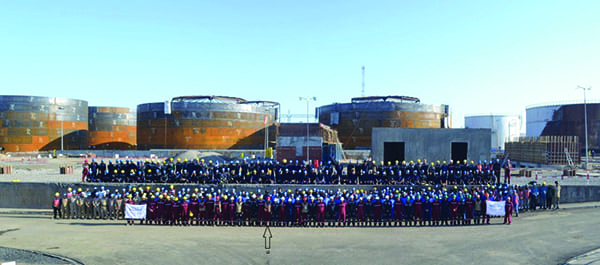Iraq Developing Solar to Complement GE, Siemens Projects
Iraq's multi-billion-dollar deal with Siemens to develop power generation projects in the country has grabbed most of the headlines this year, but the country continues to develop power projects with GE, and also in May launched a solar tender asking companies to bid for as much as 755 MW of photovoltaic (PV) generation across seven projects.
The country's Ministry of Electricity (MOE) said it invited companies to pre-qualify for the solar projects, which include 300-MW and 225-MW farms in Karbala and Babylon, respectively; 100 MW, across two 50-MW parks, in Wasit; 50-MW and 30-MW projects in Muthanna; and a 50-MW facility in Al Diwaniyah. The solar farms, expected to be operational by year-end 2020, are Iraq's first moves to diversify the country's energy mix. Iraq started to look at solar power in January, when the United Nations Development Program began seeking consultants to help the MOE develop a solar power policy. The country has long depended on coal- and gas-fired generation, and is trying to rapidly add more capacity to its national grid. The country's installed capacity in 2017 was estimated at 11.3 GW, while the country's demand for power was estimated at 17 GW.
Making up that shortfall led to Iraq's deal with GE in 2017, which included $1.4 billion in orders from the MOE to build power plants as well as provide technology upgrades and maintenance services. It was part of the country's Power Up Plan, designed to increase power generation capacity and upgrade infrastructure damaged by years of conflict in Iraq. The country has had rolling blackouts and uncertain electricity generation since the U.S.-led invasion in 2003, and infrastructure has been further damaged by the battles to retake areas of the country that were controlled by the Islamic State. The agreement with Siemens envisions increasing the country's generation capacity by as much as 50%, with an initial phase that includes construction of a 500-MW gas-fired plant in Zubaidiyah, about 45 miles south of Baghdad.
In May, GE Power announced that one of its advanced 9E gas turbines had been installed and commissioned at the Al Qudus Power Plant. The turbine is designed to operate in harsh climates, ranging from extreme heat to severe cold, and is now in service ahead of the summer season. The new turbine will add 125 MW to the plant's power generation capacity, increasing the plant's potential output to 1,250 MW. GE also provides maintenance services for the plant, which is operated by the MOE. GE in 2017 said it had secured more than $1.4 billion in orders from the MOE to build power plants as well as provide technology upgrades and maintenance services.
"Delivering additional power for the hot summer months is a priority for the Ministry of Electricity," said Musaab al-Mudarris, media director for the MOE, in a statement in late May. "One of the quickest and most cost-effective means of adding efficient, reliable power to the national grid is to enhance the productivity of existing power generation facilities. The successful delivery, installation and commissioning of a new gas turbine at Al Qudus Power Plant just 5 months after the contract was awarded is a testament to the Ministry and GE's joint commitment to powering Iraq."
 |
2. GE's $1.4 billion deal with Iraq's Ministry of Electricity has included rebuilding the Al Qayara power plant, which sat under 600 tons of rubble after years of conflict. Getting the plant back online meant restoring power to the city of Mosul and the surrounding region, a key element for the area's economy. Courtesy: GE Power |
The 9E turbine can run on more than 50 types of fuel, allowing the MOE to operate the unit with the most economical fuel type available, if natural gas is unavailable. Joseph Anis, president and CEO of GE's Gas Power Systems and Power Services businesses in the Middle East and South Asia, in a statement said, "GE is committed to delivering reliable, efficient and affordable power to help the Iraqi people strengthen their economy, re-build conflict-affected areas and support progress for present and future generations. Our teams were among the first to enter Mosul after its liberation, helping to rehabilitate the Al Qayara power plant; we are supporting the development of the country's largest power plant in Baghdad province; and we have facilitated the Ministry of Finance to unlock over $2 billion of funding for the power sector." Rebuilding the 500-MW Al Qayara plant (Figure 1) was critical to restoring power to Mosul; GE said the plant was under 600 tons of rubble when work began to bring the plant back online.
GE said it contributes as much as 55% of Iraq's power generation. The 2017 agreement called for GE to add more than 2 GW of power generation capacity in Iraq, including about 1.5 GW at the Samawa and Dhi Qar power plants. That project, completed in two phases, has included installation of four 9E gas turbines, along with heat recovery steam generators, as part of the Power Up Plan, which in phase one included adding more than 700 MW of generation capacity through upgrades to existing infrastructure, and in phase two has included adding 580 MW of generation to Iraq's national grid through upgrades and rehabilitation work at four of the country's power plants. GE also as part of phase two is performing maintenance at its 9E turbines at six of the country's power plants. Al-Mudarris said Iraq's increasing demand for electricity requires "a transformational approach" led by new projects and technology upgrades."
-Darrell Proctoris a POWER associate editor.
The post Iraq Developing Solar to Complement GE, Siemens Projects appeared first on POWER Magazine.